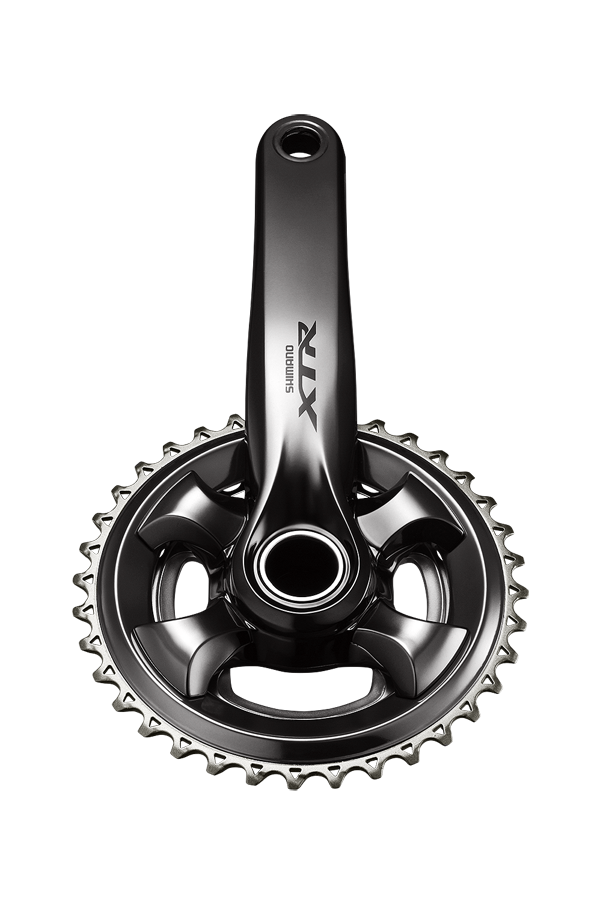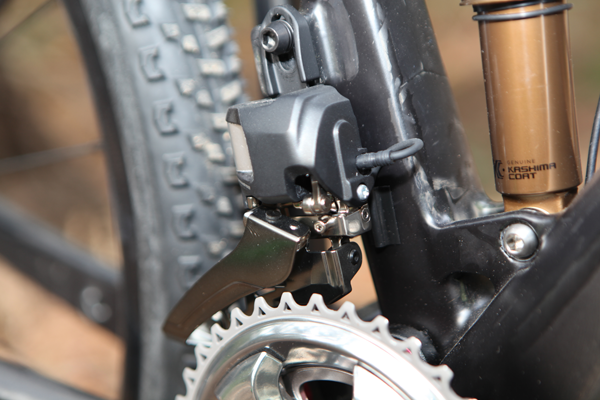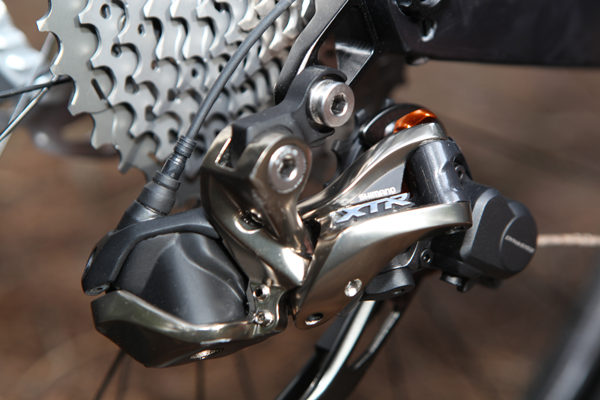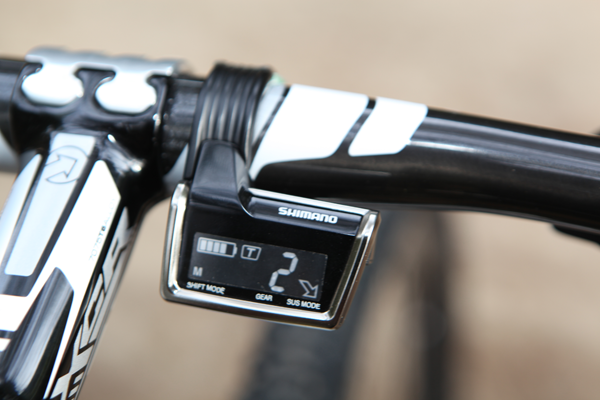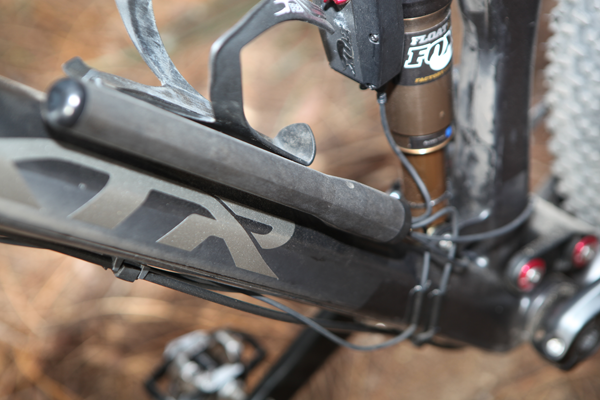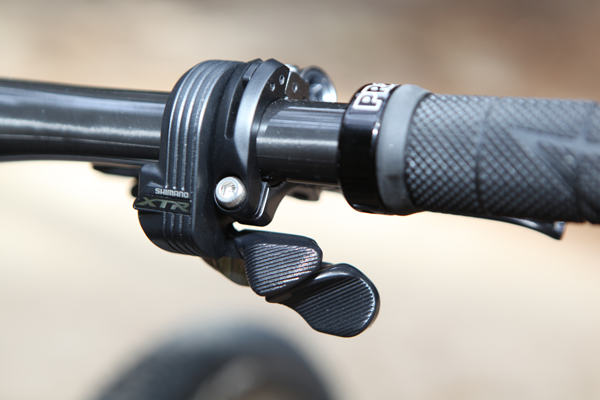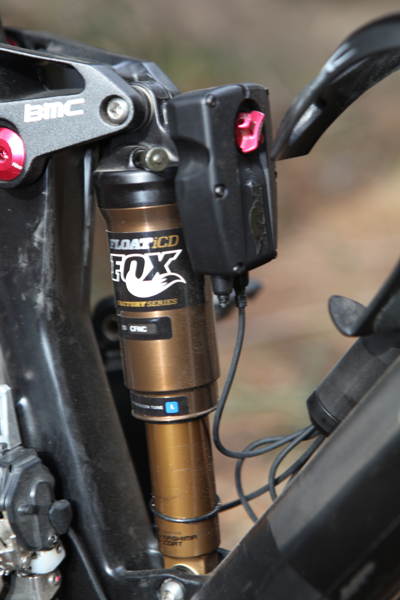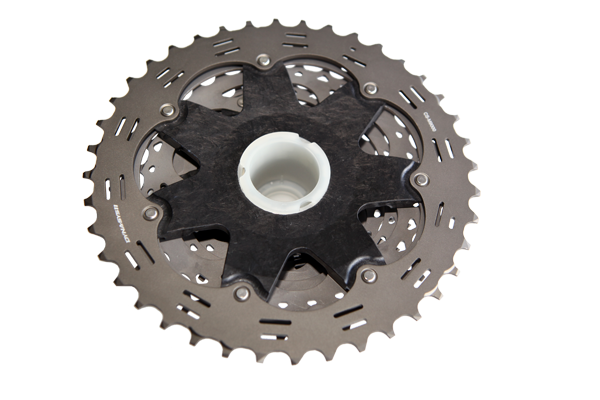Shimano XTR M9000 & M9050 Di2
Back in April Shimano launched their latest revision of their flagship XTR component group, then a month and a half later they dropped the real bombshell with the release of XTR M9050 Di2; their first MTB component group to use electronic gear shifting.
While XTR electronic won’t be available until sometime in October, we got to ride a prototype of the new system. But before we delve into this fascinating new development, let’s take a look at the updated mechanical version, as many of the features will apply to both versions of the new XTR group.
Rhythm & Range
XTR M9000 is the first Shimano MTB drivetrain to employ an 11-speed cassette. It’s also the first time they’ve had a single chainring option for a more XC or trail oriented group (Saint and Zee are more gravity focused). While the availability of a single chainring 11-speed Shimano group has been anticipated for some time, they are not touting it as the be-all answer for everyone’s needs. The new cassette offers an 11-40 gear spread. While this is wider than the 11-36 gear range offered by existing 10-speed systems, it falls some way short of the 10-42 spread provided by their main competitor (see the gear ratio chart).
Of course, with the same number of gears as the competition but a narrower total range, you get closer steps between the ratios. Shimano believes that this is the key to better performance that mountain bikers need. If you your trails or fitness level demands a wider gear range, then a multi-chainring system is the answer. The chainring combinations on their new 9000-series cranks also provide close-step ratios, with only 10-tooth jumps between one chainring and the next.
They call it ‘rhythm and range’; the close ratio gears let you keep an efficient pedalling cadence, while the multi-chainring options provide the range. So if you can’t make it up the hills with their one-by system, then you should be on 2X or 3X—simple!
In Shimano’s view, single ring drivetrains are best reserved for elite-level riders who can handle the climbs without a lower bailout gear, or for those who ride flatter terrain and can get by with a more refined gear spread. For everyone else, a double (or maybe even a triple) is the better choice.
Race & Trail
As with the previous generation XTR, certain components will be offered in ‘Race’ and ‘Trail’ versions. The Race parts are the lightest and are designed more for XC or marathon applications. Trail is more versatile and caters for everything from gravity enduro competition to general trail riding.
Cranks
An integral part of their gearing philosophy, the cranks feature a new XTR-specific spider that allows you to choose between chainring formats. They’ll also be offered in Race and Trail versions. With the Trail cranks, the one spider will convert between single, double or triple chainrings. The Race version can handle a single or double setup without modification (it can’t take a triple).
Aside from the chainring compatibility, the M-9020 Race cranks feature a narrower 158mm Q-factor or pedal stance (the Trail version is 168mm); something that may appeal to riders who spend a lot of time on a road bike and want a smoother physiological transition when they hop on the MTB. The left-side Race crank is forged in two alloy halves and then bonded together. This construction method lets them remove excess material and makes them 27g lighter than the equivalent Trail cranks.
Using a mid-sized double as a base, the M9000 Trail cranks weigh 736g (including a 90g threaded bottom bracket) and the M9020 Race equivalent version takes that down to 709g. The outgoing M980 Race double ring cranks were 723g, so the new Race cranks save around 13g. While the weight savings are minimal, the adaptability of the new cranks is a neat addition.
Titanium Teeth
With the older M980 triple, Shimano used longer lasting titanium teeth on the middle ring (Shimano refers to it as the drive ring). This feature continues and is expanded to the single and double ring formats. With a double, the big ring is deemed the main drive gear and gets the titanium treatment, as does the single chainring of the 1x11 setup.
The chainrings themselves are very elaborate, with 3D hollow alloy construction, composite shift ramps and a thin outer ring of titanium teeth on the main drive cog. With the single specific rings, Shimano uses a special tooth profile that’s said to aid chain retention and allow the 1x11 drivetrain to run without a guide. Instead of using wide/narrow teeth like most popular one-by systems, Shimano runs deep-cut teeth that are subtlety hooked. They are claimed to offer 150% more chain retention force—150% more than what? Well we don’t really know.
Cassette
I’m sure that most potential XTR users will breathe a sigh of relief that the new 11-speed cassette fits straight onto a regular MTB freehub body—at least we’ve been saved from adopting another new ‘standard’ here. To mount 11 cogs on a 10-speed freehub, Shimano profiles the end of the cassette so the 40-tooth cog sits further inboard. This buys them some room and the remainder is created by making the cog spacing fractionally narrower than 10-speed. Of course narrower spacing means an all-new narrower 11-speed chain—as with their other recent designs it will be directional.
Like the chainrings, Shimano has gone all out with the fancy materials. The 40T is alloy, the middle six cogs are titanium while the remaining small cogs are steel. All of the larger cogs are held in place by a carbon spider to trim weight and maintain stiffness. All this tallies up to a 331g cassette; a 58g increase over the 10-speed version.
Mechanical Shifting
The 11-speed rear derailleur is said to produce a lighter shifting action by better following the profile of the cassette. The angle of the parallelogram is shallower; it’s closer to being horizontal in its movement. As a result it should be more stable over bumpy ground, less prone to ghost shifts, and it stands a better chance of keeping the chain on. A chain stabilising clutch is standard spec on the M9000 derailleur and the level of clutch friction can be adjusted externally (the previous version required disassembly to do this).
There have been big moves with the front derailleur design. The new ‘Side-Swing’ system places the mechanism further forward and away from the back tyre. This provides greater clearance for modern bikes that combine larger wheels with short chainstays. On Side-Swing derailleurs, the cable enters from the front; it no longer loops down and around the bottom bracket. This results in fewer cable bends for less friction and a lighter shift action. Bike manufacturers will need to take this into account and adjust their cable routing to suit. It still uses regular style mounting points (high or low clamp as well as direct mount and E-type), so it will retrofit to most frames—you’ll just need to improvise a little with the cable routing.
One of the main drawcards that attracts people to a single ring drivechain is the silence; you no longer have the chain rattling against, or dragging along the steel front derailleur cage. Shimano attempts to address this with the cage design on the M9000 derailleurs. When compared to other Shimano derailleurs, the inner profile of the plates is flatter and smoother, producing fewer potential rub points. They also come with a number of optional nylon pads that clip to the cage with the aim of silencing chain rattles. One of these nylon silencers extends beyond the lower curve of the inner cage to reduce the chance of chain drop—it makes the front derailleur acts as top guide of sorts.
While the Trail cranks cater for both double or triple formats, the front derailleur is either double or triple specific. If you run two-by most of the time but want to mount a triple for a big alpine trip, you’ll need to buy another front derailleur to do the conversion. Of course swapping from double to single will be comparatively easy.
Beyond the additional ‘click’ in the trigger shifters, the new Rapid Fire units are said to have more ball bearings inside to provide a smoother action and better durability. They still come standard with a clamp-on bar mount but the optional i-Spec integrated brake lever mount has been redesigned. Called i-Spec II it works with the updated M9000 brake levers and offers a broader adjustment range compared to their original i-Spec system.
Weight wise the rear derailleur and triggers are close enough to the same; 221g versus 218g for the older clutch derailleur and the triggers are within a few grams as well. The new side-swing front derailleur saves around 33g; a high direct mount should be 101g compared to 134g for the M980 series.
Brakes, Pedals & Wheels
You’ll find updates in all the ancillary stuff too. The latest rendition of the brakes has a narrower clamp that works with i-Spec II and also ties neatly with the new electronic shifters. There are new 27.5 and 29-inch wheels that feature tubeless compatible carbon fibre reinforced alloy rims. They’ll be offered in Race or Trail versions with 20 and 24mm internal rim widths. New Race and Trail pedals round out the package; they are lighter (285g for Race and 369g for Trail) and claim to offer a wider, more stable interface with the shoe.
Di2 Electronic
Shimano brought electronic shifting to the road in 2009. Others like Suntour/Browning and Mavic had electronic shifting in the early 90s but Shimano made it work reliably enough for the mass market. It started out on their top-end Dura Ace group and it’s now also available at the lower Ultegra level. Campagnolo came to the party later on but offer it right through the range and SRAM has electronic shifting in development too.
While the concept is far from new, this is the first complete electronic drivetrain for mountain biking. From a MTB perspective it offers some clear benefits; cable contamination is a thing of the past, awkward cable routing will no longer compromise the shifting quality and the powerful motor driven derailleurs can execute accurate shifts under heavy pedal loads.
No doubt there will be fears over water ingress in muddy conditions but most reliability issues have already been well and truly sorted in the five years that it’s been in use on Shimano’s road groups. The concept of charging your bike may seem philosophically wrong for some, but these days charging electronic devices is a normal part of life and the Di2 battery should get you through 200-300km of riding between each 1.5 hour recharge.
Visually the derailleurs look very normal—both in terms of their size and general appearance. The shifters are more compact and the battery can be hidden in a number of locations; inside a traditional seatpost, next to a bottle mount (like a mini-pump) or hidden inside the steerer tube (a future option). Including the battery, the electronic version is only 70g heavier than the equivalent mechanical (2,178g for XTR 2x11 versus 2,248g for 2x11 Di2).
First Ride Impressions
We rode a prototype version of XTR Di2 to get an idea of how it performs. Dubbed XTR Firebolt, the shifters have a really tactile click to them—it’s far more positive and reassuring than the road version. In standard form the smaller paddle acts like the cable uptake; putting you in a lower gear on the cassette. This was the opposite of what I expected but the shift pattern is programmable, so you can change it to shift however you want.
Where it gets really tricky is with the ‘synchro-shift’ and ‘multi-shift’ features. While it can function like a gear set, you can also select a synchro mode on the bar mounted display and the right-side trigger will automatically shift both derailleurs as required. If you were in the big chainring and needed progressively lower gears, pressing the right side shifter would take you up to the second biggest cog. Upon shifting into that gear you’ll hear a beep. This warns you that the following shift in the same direction will automatically drop you to a smaller front chainring. With this it simultaneously does a quick one-cog change on the rear to compensate for the chainring shift, and you wind up in a gear that’s just a little easier to pedal. Again this is Shimano’s ‘rhythm step’ feature of maintaining a steady and even cadence between shifts.
Everything about it is clever; as you shift across the cassette, the front derailleur constantly trims itself to eliminate chain rub. The synchro feature is programmable, so you can vary the shift points for the coordinated front and rear shifting. Hold a button down and it just keeps shifting in that direction (you can custom set the shift speed for this mode). Meanwhile your chainring, cog combination and battery charge is displayed on the bars. You can even link it to Fox iCD electronic suspension, so it all runs off the one battery and the suspension setting will also show on the Di2 dashboard.
Both front and rear shifts could be executed under heavy pedalling loads; the front derailleur in particular is very assertive in the way that it shoves the chain across. While automatically coordinated front/rear shifting sounds complex, in practice it couldn’t be simpler. You only need to use the right hand shifter; keep pressing the ‘lower gear button’ and it’ll take you through the entire range while automatically keeping tabs on the chainline, minimising chainring shifts and giving you nice steady changes in cadence. Keep pressing towards higher gears and the same will happen going the other way.
In some ways it was hard for me to get my head around. Sure it couldn’t be easier to use, but my brain is firmly wired to using a traditional drivetrain. All of a sudden having half of the job taken away seems weird to begin with, like hopping into an automatic car after driving a manual all your life. I’m sure it’s something that you’d appreciate once familiar and comfortable with it.
My initial thoughts were that it’d be great when you get fatigued and clumsy on the bike—like at the end of a marathon race when you’re making silly mistakes. More than anything I think it’d be brilliant for beginners, as it effectively fool-proofs the gears. You can’t go big/big or small/small when it’s in synchro mode and it really simplifies traditional derailleur drivetrain. Unfortunately the cost will inevitably keep XTR Di2 out of reach for most riders. XTR has always been Shimano’s premium group, and using the road groupsets as a guide, we may be looking at a 60% premium for the electronic version. On a brighter note, the mechanical M9000 group is expected to be similar in price or maybe slightly less than the outgoing 10-speed XTR.
In many ways M9000 XTR isn’t what many people were expecting. While they have delivered with a 1x11 drivetrain, it doesn’t offer the widest gear spread. Shimano remain strong believers in the multi-ring drivetrain and it’s true, you can have less obtrusive jumps between gears without compromising the total gear range—but is that what the market currently wants? Will the unique new front derailleur be the answer that we’ve been waiting for? Only time will tell but we’re certainly keen to spend more time on the M9000 group to find out.

Gear Ratios - 1x11 versis 2x11
